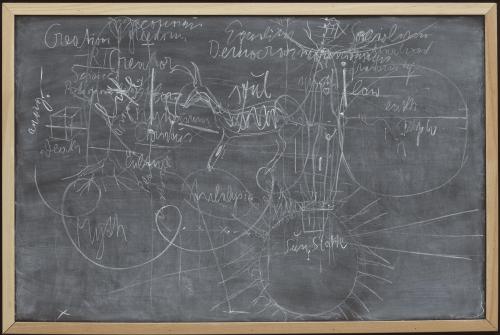Making Art History Relevant To All Generations Is Always A Challenge, But This Does The Job!
Making art history relevant to all generations is always a challenge, but this does the job!
Teaching Art History with an AI
Teaching Art History with an AI
And other unorthodox uses of MidJourney. /imagine: Monster Under the Bed, Maxfield Parrish This started because my son, who is 17 now, and in his senior year of highschool (hybrid homeschooled and community college courses) was very interested in the MidJourney images I was generating. I’ve said from the beginning that this felt as much like a game, as it did making art. Which appealed to him,…

View On WordPress
More Posts from Artfullearner and Others
I wrote about Asawa's journey to become a renowned artist and art educator in a post titled "Weaving Art with Life." Read it now on Artfully Learning: https://theartsandeducation.wordpress.com/2022/11/15/weaving-art-with-life/
![Ruth Asawa Teaching Paper Folding, Ca. 1980s [© Estate Of Ruth Asawa]](https://64.media.tumblr.com/c6697e63db07e75713b9443a406a9541/2bbbef9b26c5b1e4-6d/s500x750/168a1e1b79e95e732420c4cb6bd78cd67fab00ba.png)
Ruth Asawa teaching paper folding, ca. 1980s [© Estate of Ruth Asawa]
Playground sculptures. A fun, whimsical and culturally universal way to inspire learning!

Fiastyúk (then Thälmann) street housing estate, Budapest, 1960. From the Budapest Municipal Photography Company archive.
You know that play is an essential and profound part of humanity when it's inspired countless works of art.

Girl on the swings, 1953.
Photo: Ernst Haas via Design You Trust

Harold Cohen coloring the forms produced AARON’s drawing Turtle at the Computer Museum, Boston, MA, ca. 1982. Collection of the Computer History Museum, 102627459. Is it possible to stop worrying and learn to coexist with AI? That's the question I begin to explore in the Artfully Learning post "Living and Learning with AI?" Read here: https://theartsandeducation.wordpress.com/2023/01/17/living-and-learning-with-ai/

One of Paul Klee’s teaching notes on pictorial creation, reproduced from ‘Paul Klee: Life and Work,’ the authoritative Klee overview, back in print from @hatjecantzverlag The many books on Paul Klee (1879-1940) published over the years should not obscure the fact that there has been no new, comprehensive Klee overview since Will Grohmann’s oft-reprinted 1954 monograph. With 'Paul Klee: Life and Work,’ the @zentrumpaulklee has set out to fill this gap, drawing on a wealth of new resources including the Klee family’s archives, much of which is published here for the first time. Life and work are truly integrated in this massive, 344-page volume: Klee’s vast body of work is surveyed chronologically, as the book narrates his life alongside the abundant reproductions of drawings, paintings, watercolors, sculptures, puppets and numerous archival documents and photographs (nearly 500 reproductions in total). The book divides Klee’s career into eight periods: “Childhood and Youth”; “Munich and the Encounter with the Avant Garde”; “World War I and the Breakthrough to Success”; “At the Bauhaus in Weimar”; “Master of Modern Art”; “The Move to Dusseldorf and the Nazi Rise to Power”; “First Years of Emigration in Bern”; and “Final Years.” The result of many years of research and labor, this magisterial publication demonstrates conclusively why Klee numbers among the most influential and best-loved artists of the past 100 years. Read more via linkinbio. #paulklee #klee #bauhhaus #pictorialcreation #pedagogy #teachingnotes #abstraction https://www.instagram.com/p/CNVmXWQppb_/?igshid=1a3e8wtaf3oag

Set and props from Jayson Musson: His History of Art at the Fabric Museum and Workshop, Philadelphia, PA. Photograph by Esther Welsh
I went to Philly to see "His History of Art" by Jayson Musson at the Fabric Workshop and Museum and wrote about its pedagogical use of satire to challenge art educational conventions on my blog Artfully Learning. Read about it in the post "Whose History of Art?"

Zoë Buckman, "Help I Work at the Ministry," c.1995, fabric and mixed media. Arts writer Priscilla Frank (2017) explains that, “when she was 10 years old, Buckman’s father got a job as a statistician at the Ministry of Defense in London. Imagining her father going to work at such an official building was humorous for her. Having overheard her parents speak of the long process of him receiving security clearance, she wanted to sew him a tie and entrap it in a glass frame.” . Read more about this artwork and others in my blog post "The Childhood Origins of Working Artists" Here's the link to my piece: https://theartsandeducation.wordpress.com/2023/01/13/the-childhood-origins-of-working-artists/
![Ruth Asawa Teaching Paper Folding, Ca. 1980s [© Estate Of Ruth Asawa]](https://64.media.tumblr.com/c6697e63db07e75713b9443a406a9541/2bbbef9b26c5b1e4-6d/s500x750/168a1e1b79e95e732420c4cb6bd78cd67fab00ba.png)
Ruth Asawa teaching paper folding, ca. 1980s [© Estate of Ruth Asawa]

Helen Levitt, Graffiti: Chalk Drawing of Figure with Double Pupils, New York City, c.1940, gelatin silver print. Source: The Metropolitan Museum of Art
American photographer Helen Levitt is known for her documentary and candid style street photography of everyday life. One of her recurring subjects is children at play. She also captured their whimsical works of art, such as this 1940s photograph of a children's chalk drawing in New York City.
-
 artfullearner reblogged this · 2 years ago
artfullearner reblogged this · 2 years ago -
 artfullearner reblogged this · 2 years ago
artfullearner reblogged this · 2 years ago -
 artfullearner liked this · 2 years ago
artfullearner liked this · 2 years ago -
 cedarlili reblogged this · 2 years ago
cedarlili reblogged this · 2 years ago

Art + Education Blog: Artfully Learning Podcast: Artfully Learning Audio Series
54 posts
